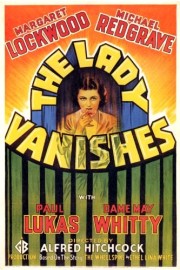The Lady Vanishes
It’s been far too long since I last watched Alfred Hitchcock’s “The Lady Vanishes.” When I first saw it many years ago, it quickly moved up the list of my favorite Hitchcock films. What’s interesting is that the parts I remembered most from the film were the scenes on the train, which make up the bulk of the story, all but forgetting the setup at the hotel the night before the characters embark on the train ride. In those early scenes, we see character dynamics that will pay off later, political situations that will cast a cloud over the film, and the beginning one of of Hitch’s most entertaining films.
Based on a novel by Ethel Lina White, “Vanishes” is the story of a young woman named Iris Henderson (Margaret Lockwood), who is on a train heading home to her life and prospective fiancee. Before getting on the train, she has a knock on the head, which an old woman (Miss Froy, played by Dame May Whitty) helps her with. They become friends, go for tea, and return to their compartment. Iris falls asleep, and when she wakes up, Miss Froy is gone. The catch? Nobody, no even the people they share a compartment with, acknowledges seeing or talking with the old woman. Iris finds an ally in Gilbert (Michael Redgrave), a clarinet player she had an argument with at the hotel, but nobody else believes her, and a doctor (Paul Lukas) convinces her that she is imagining the whole thing. Iris believes the doctor until she sees physical evidence of their conversation. The question is whether she can uncover this conspiracy before it’s too late.
This isn’t the visually elegant, and daring, Hitchcock we see at work in his American films (which started with his next film, “Rebecca”), but a director focusing on character and the mechanics of storytelling, digging into an intelligent, nuanced script by Sydney Gilliat and Frank Launder. The film contains some visual tricks to imply hallucinations on Iris’s part, but this is one of the most straightforward stories Hitchcock ever told, and that straightforward approach is ideal given the mystery at it’s center. One of the biggest reasons it stands out, though, is it’s sense of humor, which is dry and witty in that classic British mold, and essential to the film’s points about the growing tensions in Europe as WWII loomed. This is an ensemble picture more than pretty much any other Hitchcock film, and it includes many sharp characters like the couple who acts married, but is, in fact, having an affair; a woman in a nun’s outfit that has secrets to share; a couple of friends, and cricket fans, who find themselves in the middle of the action; and a woman who pretends to be the old woman, but Iris knows the difference. All of these characters add a rich and beguiling world created by Hitchcock, and turn “The Lady Vanishes” into one of the master’s more enduring pleasures.










